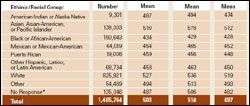Average SAT scores for this year’s high school graduates—the first class to have undergone the revamped test that was introduced in March 2005—dipped 7 points below last year’s composite scores for both the mathematics and critical-reading sections, according to a report released today by the College Board, the New York City-based nonprofit organization that sponsors the test.
Some observers say the drop in scores could be partly explained by the revisions, which made the college-admissions exam longer, and possibly more challenging. Test-takers are given 45 more minutes to take the longer, newer version than the previous test, and the test now includes a writing section, more advanced math, and a revamped reading section that uses longer passages to test comprehension. Though the new version was administered three times in the spring of last year, it was not reflected in the report on scores for the class of 2005.
Further information on the 2006 results, including links to the report and charts and data, is available from the College Baord.
The College Board attributed the drop in scores largely to changes in test-taking patterns, including the fact that fewer students in the class of 2006 chose to retake the test. It noted that students who take the SAT a second time typically see a bounce of about 30 points on the math and reading sections combined on their second attempts.
“When a new test is introduced, students usually vary their test-taking behavior in a variety of ways and this affects scores,” Gaston Caperton, the president of the College Board, said in a statement.
The National Center for Fair & Open Testing, or FairTest, a Cambridge, Mass.-based critic of the standardized-testing industry, said that many test-takers could have been discouraged by the prospect of sitting through the longer test a second time, or turned off by the higher fee, which went from $29.50 to $41.50.
About 1.45 million students, or 48 percent of this year’s high school graduates, took the SAT during the 2005-06 school year—a decrease of about 10,000 students from the previous school year’s total. The average mathematics score dropped by 2 points, to 518, while the average score on the critical-reading portion fell about 5 points, to 503, according to the College Board’s report. Each section has a possible maximum score of 800. The average score for the critical reading section for male test-takers dropped 8 points, to 505, while the average for females fell 3 points, to 502.
Math scores have generally increased slightly from year to year over the past decade, usually increasing by about a point or two a year, while reading scores have varied more, said Christine S. Parker, the executive director of high school program development for the Princeton Review, a New York City-based test-preparation company. She called the 5-point decline in critical-reading scores significant.
The revised test has a potential total score of 2400, for its three sections, up from a 1600-point maximum on the old, two-section SAT.
Fatigue Factor?
Caren L. Scoropanos, a spokeswoman for the College Board, said the new test was designed so that students would receive scores similar to those they would have gotten on the previous exam. She said the changes were intended to better reflect what students are taught in the classroom, not to make the test harder.
Except for Asian-Americans, a large gap exists between minority and white students who took the revamped SAT.
*Click image to see the full chart.

*No response indicates that students did not answer that question, did not complete the SAT Questionnaire, or stated they did not wish to answer that question on their SAT Questionnaire.
SOURCE: College Board
For instance, she said, while the new test includes questions that measure Algebra 2 skills, it contains the same number of easy, medium, and difficult math questions. She also said that parts of the new critical-reading section are designed to test the same kind of analytical skills that the word analogies contained in the verbal section of the old exam were supposed to measure.
But Ms. Parker of the Princeton Review said she was skeptical that the new test has the same difficulty level as the previous version. “I don’t see how you can expect a more advanced year of math, but not make the test harder,” she said. “That seems a little strange to me.”
She added that more interpretative questions could also make the critical-reading section more challenging. “Interpretative reasoning is a fuzzier task,” she said.
Beyond those reasons, Ms. Parker said some students she has spoken to found the new test grueling. She said that by the time the exam is over, including time for administrative work, students have spent nearly five hours at the testing center. “Their brains are just spent,” she said.
But Ms. Scoropanos dismissed the idea that the longer test could have created a “fatigue factor,” saying that the College Board had done an analysis of 700,000 students that showed that the longer test did not significantly affect performance. She said while students may have been tired after the longer test, that feeling did not change their scores.
Girls Outperform Boys
Some praised the writing section—the major addition to the revised SAT—as giving female test-takers, who have traditionally not done as well on the test as their male counterparts, a greater chance to shine. Girls performed better than boys on the writing section, which contains both multiple-choice questions and an essay.
The average writing score for all students was 497 out of a possible 800. Female students scored an average of 502, besting their male counterparts by 11 points. That gender pattern was apparent across every racial and ethnic group, the College Board said.
“This is a better test in terms of equity for the students,” said Annette L. Riffle, the general manager of Kaplan Premier Private Tutoring, a private tutoring service for the SAT and ACT admissions exams, at Kaplan, Inc., a New York City-based test-preparation company.




